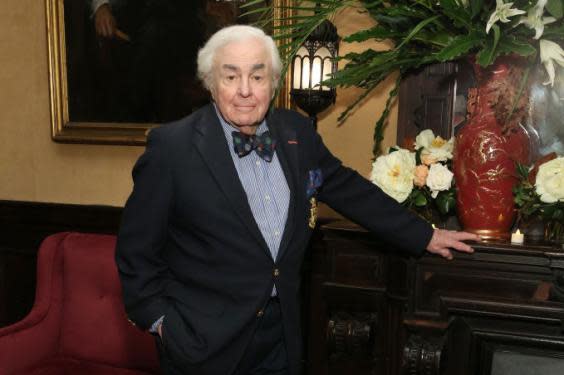Everett Kinstler: Prolific American portrait artist who painted presidents and film stars
As one of America’s foremost portrait artists, Everett Raymond Kinstler had presidents Nixon, Carter, Reagan, Bush Sr, Clinton and Bush Jr sit for him. In 2010 he painted yet-to-be-president Donald Trump. The only White House resident he missed out in that time was Obama.
Kinstler, who has died aged 92, began his career as an illustrator of comics.
After dropping out of high school aged 15, he made his living as an artist for more than 75 years. He was never part of the avant-garde or featured in cutting-edge art world shows, but his realistic portrait studies – all based on hours-long sessions with his subjects – made him one of the most popular and successful artists of his time.
In 2016, Kinstler estimated that he had painted at least 2,500 portraits on commission, then added: “I think that’s conservative.”
He didn’t depict his subjects with photographic precision but painted in a slightly impressionistic style, sometimes making famous faces appear slightly younger or more heroic than they were in real life.
Kinstler’s brushstrokes were plainly visible in his work, creating the paradoxical sensation that his paintings were quickly dashed off, yet crafted with deliberate observation.
“The camera records a moment,” he told The New York Times in 1989. “The painter makes a statement.”
After working as comic book and magazine illustrator, he turned to portrait painting in the late 1950s. One of his first subjects was Forrest E Mars Jr, whose family’s sweet empire, based in McLean, Virginia, produces Snickers, Milky Way and M&Ms.
In the early 1960s, Kinstler painted astronauts Scott Carpenter and Alan Shepard Jr and soon moved into the orbit of official Washington, with portraits of several members of the cabinet of President Lyndon B Johnson. He eventually painted more than 50 cabinet officials, including two portraits of Robert Gates, once as CIA director in the 1990s and again as Barack Obama’s defence secretary in 2012.
“A sure sign you’ve been in Washington too long is when Ray Kinstler has more than one crack at your portrait a generation apart,” Gates quipped to Time magazine,
The first president Kinstler painted was Richard Nixon, whom he found cold and aloof.

He had better luck with other commanders in chief, portraying all of them from Nixon through to Donald Trump, with the exception of Obama. (He painted Trump in 2010, before he ran for office.)
He often painted multiple portraits of a single subject, including more than 10 of President Gerald Ford, with whom he had a particular rapport. He also made several paintings each of presidents Ronald Reagan, George Bush Snr and Bill Clinton.
Kinstler has 84 works in the collection of the Smithsonian Institution’s National Portrait Gallery, and his paintings of Ford and Reagan are the official White House portraits. His work was often shown in museum exhibitions and featured in books.
Over the years, Kinstler painted portraits of actors John Wayne, Jason Robards, Gregory Peck, Carol Burnett and Clint Eastwood; first ladies Betty Ford and Laura Bush; and authors Tennessee Williams, Tom Wolfe and Dr Seuss.
Many high-powered people posed for Kinstler, but the one who filled him with terror was actress Katharine Hepburn. “Though we crossed swords, we ended up friends,” he said – they had argued over a cigarette she was holding.
Everett Raymond Kinstler was born 5 August, 1926, in Manhattan. His father was a businessman, his mother a homemaker.
He showed early talent in art and left high school to “ink” the drawings of comic book artists. (One of his high school classmates was singer Tony Bennett, a serious avocational painter who later became a close friend.)
After serving in the army during the Second World War, Kinstler returned to his work as illustrator, moving on to pulp magazines and lurid paperback book covers – what he called “cowboys and cleavage”.
“I was consumed with working,” he told the Santa Fe New Mexican in 2006. “It wasn’t unusual for me to get a cup of coffee and a Camel cigarette and work on the drawing board around the clock. I worked seven days a week.”
His early artistic models included painter John Singer Sargent and illustrator James Montgomery Flagg, who created the “I Want You” poster of Uncle Sam during the First World War. In the 1940s, Kinstler befriended Flagg, who looked at his work and declared: “You’re doomed to be an artist.”
Kinstler, who lived in Easton, Connecticut, was booked years in advance for portraits, earning as much as $100,000 apiece. He taught at the Art Students League and the National Arts Club in New York, where he maintained a studio until shortly before his death.
His first marriage, to Lea Nation, ended in divorce. Survivors include his wife since 1996, the former Peggy Chartier; two daughters from his first marriage; three stepchildren; and nine grandchildren.
One of the many actors Kinstler portrayed was James Cagney, who often played tough guys in Hollywood movies. He was sitting with Cagney once when a young actor approached him for advice.
“And Jim looked over at the fellow,” Kinstler said in 2006, “and said, ‘Kid, learn your lines, be honest, plant your feet on the ground, and when you say something, mean it.’ And the way he said that still gives me chills.
“That’s the way I approach my own work. I learn my lines, I do the best I can, and I mean it.”
Everett Raymond Kinstler, portrait artist, born 5 August 1926, died 26 May 2019
© Washington Post

